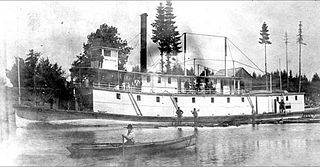
Three Sisters was a sternwheel-driven steamboat that operated on the Willamette River from 1886 to 1896. The steamer was built as an extreme shallow-draft vessel, to permit it to reach points on the upper Willamette river such as Corvallis, Harrisburg and Eugene, Oregon during summer months when water levels in the river were generally low. The vessel was also known for having been washed up on a county road in Oregon during a flood in 1890.

Unio was a small sternwheel-driven steamboat which operated on the Willamette and Yamhill rivers from 1861 to 1869. This vessel is primarily remembered for its having been named Unio when built in 1861, in the first year of the American Civil War, and then having the name completed, to Union, by a new, staunchly pro-Union owner, James D. Miller. Union appears to have sunk in 1869, been salvaged, and then dismantled, with the machinery going to a new steamer then being built for service on the Umpqua River.

The People's Transportation Company operated steamboats on the Willamette River and its tributaries, the Yamhill and Tualatin rivers, in the State of Oregon from 1862 to 1871. For a brief time this company operated steamers on the Columbia River, and for about two months in 1864, the company operated a small steamer on the Clackamas River.
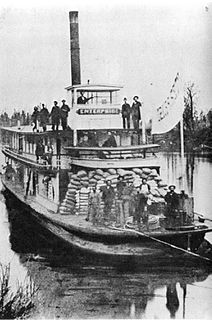
Enterprise was a sternwheel steamboat that operated on the Willamette River from 1863 to 1875. This vessel should not be confused with several other steamers named Enterprise which operated in the Pacific Northwest at about the some time.

Alert was a sternwheeler steamboat which operated on the Willamette River, in Oregon, United States, from 1865 to 1875. Originally built for and owned by the Willamette Steam Navigation Co., it was soon acquired by the People's Transportation Company, a steamboat line which held a near-monopoly on Willamette River transportation. This vessel was rebuilt in 1871, and ran until 1875, when it was dismantled.

Alice was a stern-wheel driven steamboat that operated on the Willamette and Columbia rivers in the 1870s and 1880s. Alice was the largest vessel built above Willamette Falls and was considered in its day to be the "Queen of the River". This steamer was rebuilt after near-destruction in a fire at Oregon City, Oregon in May 1873. In 1876, it was withdrawn from the upper Willamette River and transferred to the Columbia River, where it was worked as a towboat moving ocean-going ships to and from Portland and Astoria, Oregon, near the mouth of the Columbia River.

Wenat was a stern-wheel steamboat that, under the name Swan, was built and operated, briefly, on the Tualatin River, in the state of Oregon. In 1858, Swan was sold, moved to the lower Willamette River, renamed Cowlitz, and placed on a route between Portland, Oregon the Cowlitz River.

Dayton was a steamboat which operated on the Willamette and Columbia rivers from 1868 to 1881. Dayton operated on the Willamette from 1868 to 1876, mostly upriver from Willamette Falls, including a route on the Yamhill River to Dayton, Oregon, after which the steamer was named. From 1876 to 1881, Dayton was employed on a run from Portland to Monticello, W.T., which was located on the site of what is now Longview, Washington.

Senator was a stern-wheel-driven steamboat which operated on the Willamette River in the state of Oregon from 1863 to 1875. Senator is chiefly remembered for its having been destroyed in a fatal boiler explosion in 1875 while making a landing at the Portland, Oregon waterfront in 1875.

Albany was a stern-wheel driven steamboat that operated on the Willamette River from 1868 to 1875. This vessel should not be confused with the later sternwheeler Albany, which ran, also on the Willamette River, from 1896 to 1906, when it was rebuilt and renamed Georgie Burton.

Active was a stern-wheel driven steamboat that operated on the upper Willamette River from 1865 to 1872. During its short operational life, Active was owned by several different steamboat companies. It was dismantled in 1872 at Canemah, Oregon.
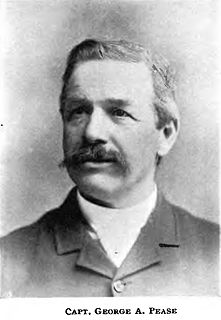
George Anson Pease was a well-known steamboat captain in the Pacific Northwest region on the United States, who was active from the earliest days of steamboat navigation on the Willamette River in the 1850s. He worked in various roles until the early 1900s, commanding numerous vessels during that time. During a flood in 1861, while in command of the sternwheeler Onward, Pease rescued 40 people from a flood in the area of Salem, Oregon.

John H. Couch was a side-wheel driven steamboat that operated on the Columbia and lower Willamette rivers from 1863 to 1873. Informally the vessel was known as the Couch.

No Wonder was a stern-wheel driven steamboat that operated on the Willamette, Columbia and Cowlitz rivers from 1889 to 1930. No Wonder was originally built in 1877 as Wonder, which was dismantled in 1888, with components being shifted over to a new hull, which when launched in late 1889 was called No Wonder.

Fanny Patton was a stern-wheel driven steamboat that operated on the Willamette River, in Oregon, starting in August 1865. This steamer operated from 1865 to 1880 for various owners, and was a considered a profitable vessel. The steamer was named for the daughter of businessman Edwin N Cook, Frances Mary "Fannie" Cooke (1837–1886), who married Thomas McFadden Patton in 1854. Edwin N. Cook was one of the principals of the People's Transportation Company.

Orient was a light-draft sternwheel-driven steamboat built in 1875 for the Willamette River Transportation Company, a concern owned by pioneer businessman Ben Holladay. Shortly after its completion, it was acquired by the Oregon Steam Navigation Company. Orient was a near-twin vessel of a steamer built at the same time, the Occident.

Governor Newell was a sternwheel-driven steamboat that operated from 1883 to 1902 in the Pacific Northwest.
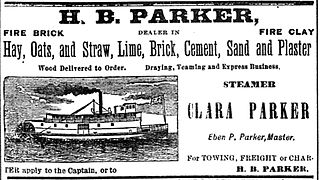
Clara Parker was a sternwheel-driven steamboat which was operated on the lower Columbia and lower Willamette rivers in the 1880s. The steamer ran for about ten years out of Astoria, Oregon in towing and jobbing work. In 1890 Clara Parker was rebuilt and renamed Astorian.
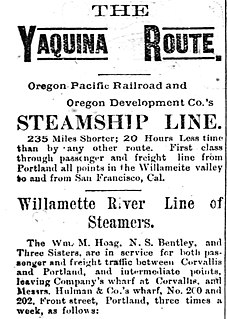
N.S. Bentley, commonly referred to as simply Bentley, was a stern-wheel driven steamboat that operated on the Willamette rivers. Launched in East Portland in December 1886, Bentley ran until 1896, when it was rebuilt and renamed Albany. Bentley was owned by the Oregon Pacific Railway, and was used as part of a rail and marine link from Portland to San Francisco, running down the Willamette, then to Yaquina Bay, and then by ocean steamer south to California. In 1896, Bentley was rebuilt and renamed Albany.

Undine was a sternwheel-driven steamboat that operated from 1887 to 1935 on the Columbia and lower Willamette rivers. From 1935 to 1940 the same vessel was operated under the name The Dalles.



















